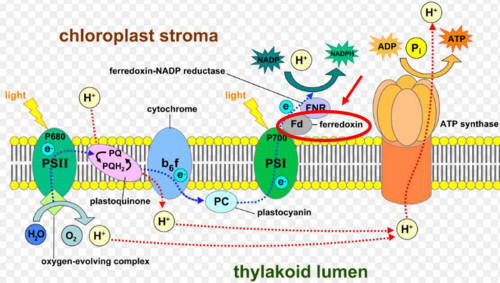Get to Know the Role of Iron in Photosynthesis!

(the photophosphorylation process)
| Home | Procedure | Troubleshooting | Sample Results | Contact Us | Bibliography | Acknowledgments |
| Introduction |
|
Get to Know the Role of Iron in Photosynthesis! |
||
| The major role of iron during the photosynthesis process, occurs during the first stage of photosynthesis, called photophosphorylation (shown in the figure to the right). This initial stage of photosynthesis includes light dependant reactions that convert light energy to chemical energy with two products: NADPH as well as ATP. During photophosphorylation, once light is absorbed in a chloroplast, the energy undergoes movement through a more complex photosystem within the thylakoid membrane, where there are critical protein molecules that transfer electrons to create the two products of the chemical process. As this light energy is absorbed by chlorophyll and absorbed as electrons, these electrons pass through the photosystem and through protein molecules. One of these protein molecules that the electrons encounter in order to turn the light energy into chemical energy is ferredoxin; a iron-sulfate protein (circled in the figure to the right). For further reading on photophosporylation, click here. |
 (the photophosphorylation process) |
|
| Picture courtesy of Wikipedia.org | ||
|
What We Know: |
||
|
Different species of plants undergo
photosynthesis at different rates, resulting in varying amount of iron
being consumed by a plant in order for the photophosphorylation process
to occur. For example, the position of a leaf on a tree affects its
photosynthesis process, depending on the amount of sunlight it receives.
As a leaf receives more sunlight, the rate at which the light energy is
absorbed and converted into chemical energy increases. |
|
|
| Picture courtesy of rhodoland.net and motherwarthnews.com | ||
| Why Photosynthesis? | ||
| For the past few years, there has been an unexpected relationship between iron levels and pH at the E.S.S.R.E sites. Generally, the more acidic the soil, the more iron there should be; there should be an inverse relationship. For further reading on the relationship between iron and pH, click here. However, this expected relationship sometimes has not been observed. Therefore, we concluded that the species of plants and their respective photosynthesis process might be contributing to the varying iron levels. |
(the inverse relationship between iron and pH) |
|
|
Going out to the real world! |
|
|
To investigate further about iron and photosynthesis, different dominant
species can be studied to observe their iron uptake and analyze the role
of photosynthesis in the iron uptake process. As the abudance of
chlophyll b potentially affects the different rates of photosynthesis in
a plant, and therefore its iron uptake, the dominant species compared
can be plants with darker leaves versus lighter shades of leaves (shown in
picture to the right) . |